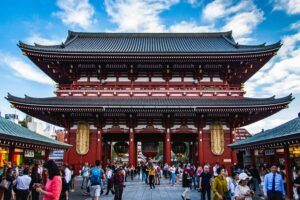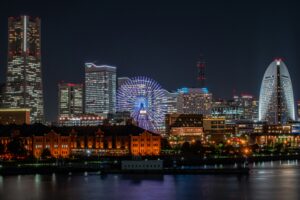Unveiling the Richness of Sensō-ji: Tokyo’s Oldest Temple
Translate Post:

Nestled in the heart of Tokyo lies a timeless treasure steeped in history, spirituality, and cultural heritage – Sensō-ji. Let’s embark on a journey to explore the allure of this iconic Buddhist temple and uncover the secrets it holds within its ancient walls.
Discovering the Origins of Sensō-ji
Sensō-ji traces its origins back over a millennium, making it Tokyo’s oldest temple. Legend has it that the temple was founded in 628 AD when two fishermen discovered a golden statue of Kannon, the Buddhist goddess of mercy, in the nearby Sumida River. Over the centuries, Sensō-ji has evolved into a revered pilgrimage site and a symbol of resilience and faith for the Japanese people.
Marveling at the Architecture and Design

As you step through the imposing Thunder Gate (Kaminarimon), adorned with its iconic red lantern, you’ll be transported back in time to an era of exquisite craftsmanship and intricate design. The main hall (Hondō) of Sensō-ji, with its elegant curved roof and ornate carvings, stands as a testament to the temple’s architectural prowess and spiritual significance.
Understanding the Cultural Significance
Sensō-ji holds a special place in the hearts of the Japanese people, serving as a focal point for religious observance, cultural celebrations, and community gatherings. Visitors can experience traditional rituals such as omikuji (fortune-telling strips), o-mamori (protective amulets), and incense offerings, immersing themselves in the rich tapestry of Japanese spirituality and tradition.
Immersing Yourself in the Visitor Experience

Exploring Sensō-ji is a sensory feast for the soul, with the heady scent of incense mingling with the sound of chanting monks and the sight of colorful prayer flags fluttering in the breeze. Take a leisurely stroll through the temple grounds, pausing to admire the tranquil beauty of the Asakusa Shrine and the picturesque garden of the Hōzōmon Gate.
Exploring the Surrounding Attractions
Beyond Sensō-ji, the bustling streets of Asakusa beckon with a wealth of attractions waiting to be discovered. Lose yourself in the vibrant atmosphere of Nakamise-dori, a bustling shopping street lined with traditional stalls selling souvenirs, street food, and handicrafts. Nearby, the Asakusa Culture and Tourist Information Center offers panoramic views of the city skyline from its observation deck, providing the perfect vantage point to capture the essence of Tokyo.
Essential Tips for Visitors
Before embarking on your journey to Sensō-ji, here are a few tips to ensure a memorable and enjoyable experience. Arrive early in the day to avoid the crowds and take advantage of the serene atmosphere. Dress respectfully, covering your shoulders and knees out of respect for the temple’s sacredness. Lastly, don’t forget to try the local delicacies, such as freshly grilled senbei (rice crackers) and sweet melon pan (bread), available from the street vendors outside the temple grounds.
Embracing the Spirit of Sensō-ji

Sensō-ji is more than just a temple; it’s a testament to Japan’s enduring spirit and cultural heritage. Whether you’re seeking spiritual enlightenment, cultural immersion, or simply a moment of peace and tranquility amidst the hustle and bustle of Tokyo, Sensō-ji offers a sanctuary for the soul. So, come and experience the magic of Sensō-ji for yourself, and let its timeless charm captivate your heart and mind.
FAQs (Frequently Asked Questions):
- Is there an entrance fee to visit Sensō-ji?
- No, Sensō-ji is free to enter for all visitors. However, donations are welcome to support the upkeep and maintenance of the temple grounds.
- What is the best time of day to visit Sensō-ji?
- Early morning or late afternoon are ideal times to visit Sensō-ji to avoid the crowds and experience a more peaceful atmosphere.
- Are there any cultural events or festivals held at Sensō-ji throughout the year?
- Yes, Sensō-ji hosts several cultural events and festivals, including the Sanja Matsuri in May and the Hōzuki Market in July, where visitors can experience traditional rituals, performances, and festivities.
- Can I take photographs inside Sensō-ji?
- Yes, visitors are welcome to take photographs inside Sensō-ji, but it’s important to be respectful of worshippers and refrain from using flash photography during religious ceremonies.
- Is Sensō-ji accessible for wheelchair users and individuals with mobility issues?
- While Sensō-ji is accessible to some extent, certain areas may pose challenges for wheelchair users due to uneven terrain and steps. However, there are ramps and accessible facilities available to accommodate visitors with mobility issues.









